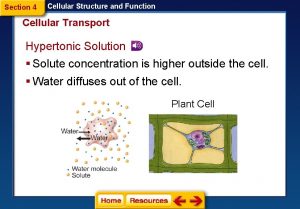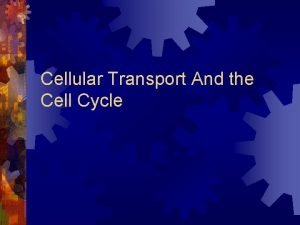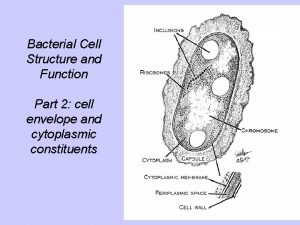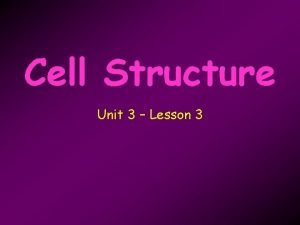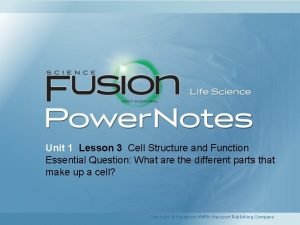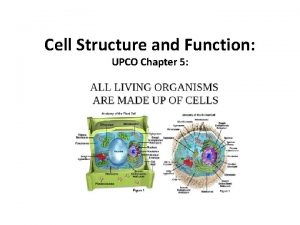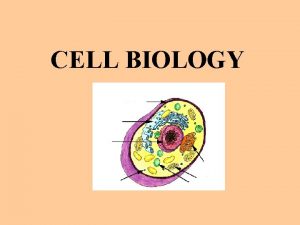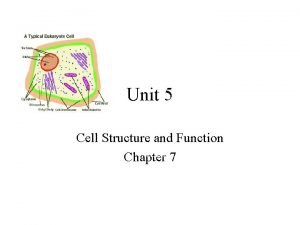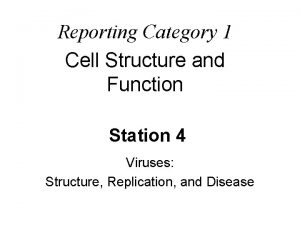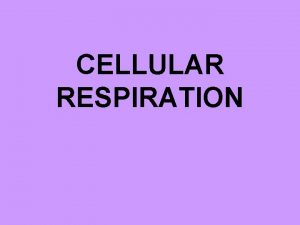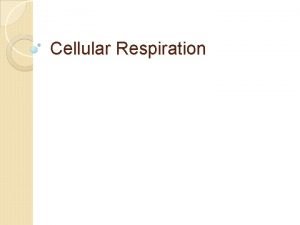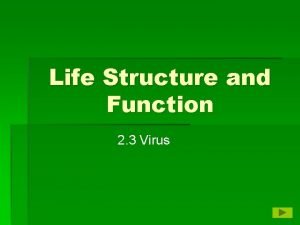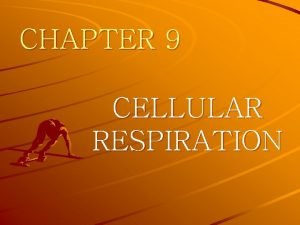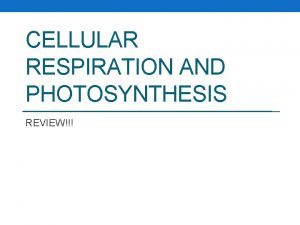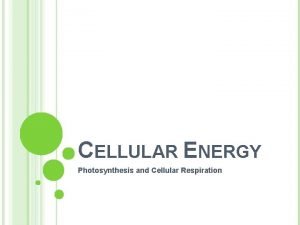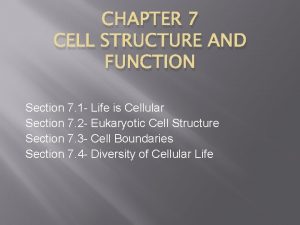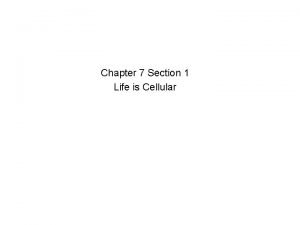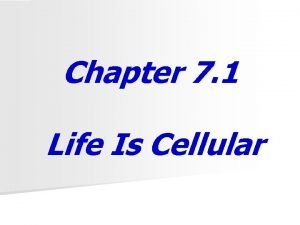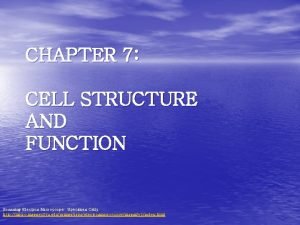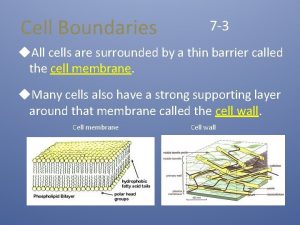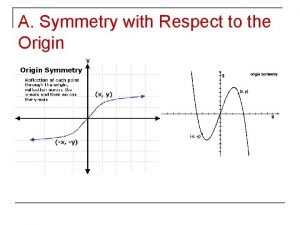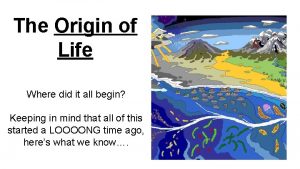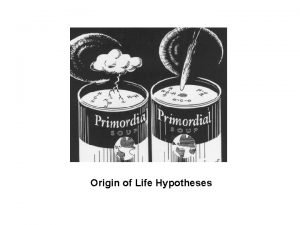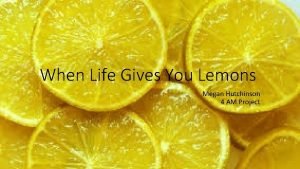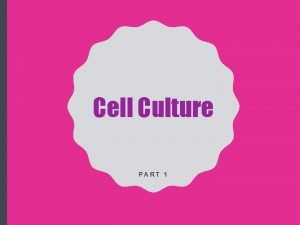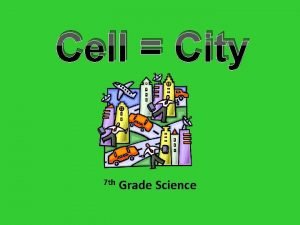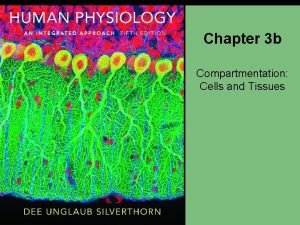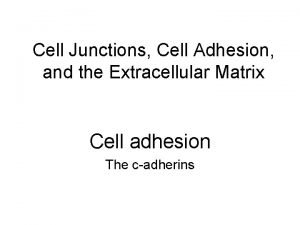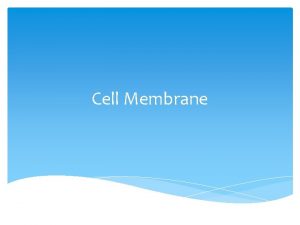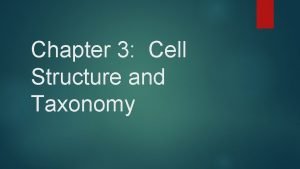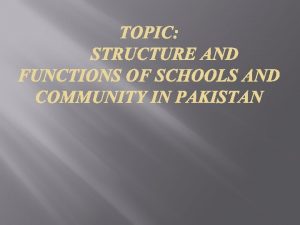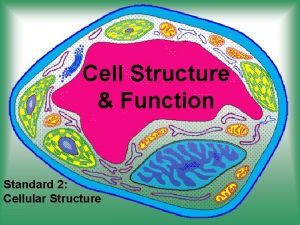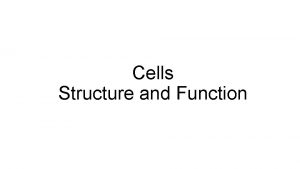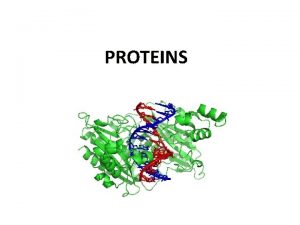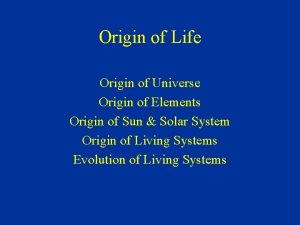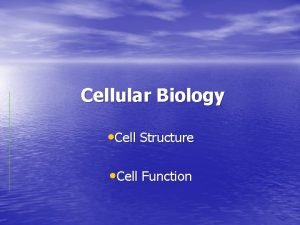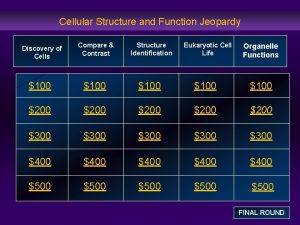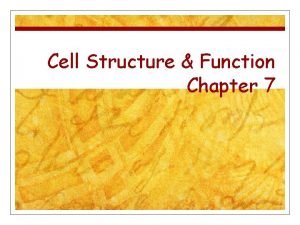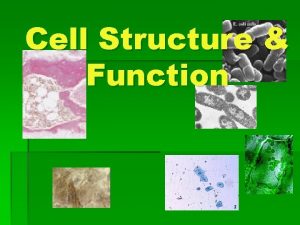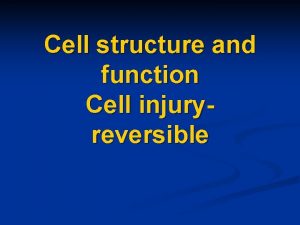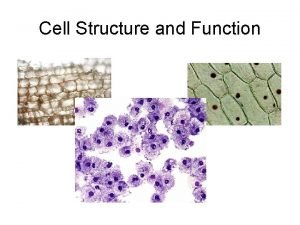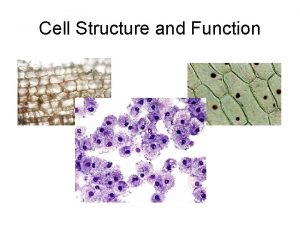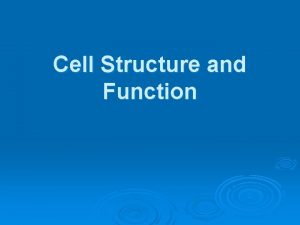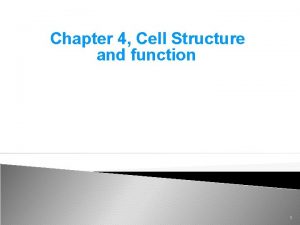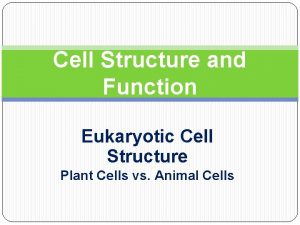Cell Structure and Function Origin of Cellular Life



































































- Slides: 67

Cell Structure and Function

Origin of Cellular Life • The Earth formed about 4. 6 billion years ago. ▫ For about 500 million years, the Earth was continually bombarded by chunks of rock and ice in the solar system. • The early atmosphere of Earth contained: ▫ ▫ ▫ Water vapor H 2 O Nitrogen N 2 Carbon dioxide CO 2 Methane CH 4 Ammonia NH 3

Origin of Cellular Life • How did life arise from such a harsh environment? • Two scientists designed a model of what conditions were like on Earth at this time, called the Miller-Urey Apparatus.

Miller-Urey Apparatus • This apparatus simulated three important conditions on Earth. ▫ Electrodes simulated atmospheric lightning ▫ Gases similar to those in early Earth’s atmosphere ▫ Evaporation and precipitation in the water cycle • After 2 weeks, 10 -15% of the carbon had been used to form sugars, amino acids, and parts of nucleic acids.

Cell Theory • The cell theory states that all living organisms are made of cells. ▫ Cells express all the characteristics of life: reproduction, response to stimuli, etc. ▫ All cells are produced through the division of pre-existing cells. ▫ Each cell maintains homeostasis, a constant internal environment.

The First Cells • Prokaryotic organisms are single-celled and have no nuclei or organelles. ▫ Their DNA or RNA is usually floating freely inside the cell.

Eukaryotic Cells • Eukaryotes are organisms with much larger and more complex cells than prokaryotes. ▫ DNA is in a nucleus that is bounded by a nuclear membrane. ▫ Have membrane-bound organelles • The largest eukaryotic cells are 0. 1 mm to 1. 0 mm in size. Why haven’t they evolved any larger?

• The biggest limiting factor to cell size is the surface area available through its plasma membrane. ▫ Without sufficient surface area, the cell cannot absorb nutrients or excrete wastes fast enough to survive.

• The largest cell in the human body is the egg, at about 0. 13 mm in diameter. ▫ The smallest is the sperm cell at 0. 05 mm.

Plasma Membrane • The plasma membrane is the barrier that separates the cell from the external environment. ▫ Physical isolation between the internal cellular and external environments. ▫ Regulation of nutrient/waste exchange. ▫ Sensing changes in the environment or receiving communication signals from other parts of the body. ▫ Connecting to other cells, giving body tissues a stable structure.

• The main component of plasma membranes is phospholipids. ▫ The two fatty acid tails are hydrophobic; insoluble in water. ▫ The phosphate head is hydrophilic; water-soluble. • The phospholipids naturally form a bilayer. ▫ The hydrophobic fatty acid tails form the middle layer. ▫ The hydrophilic phosphates form the outer layers.

• Any transportation, communication, or other functions that occur on the cell membrane must take place through proteins.

• Receptor proteins will respond to specific chemical signals. ▫ Example: Hormone receptors • Carrier proteins transport substances across the cell membrane. ▫ Example: Glucose transporter

• Enzymes increase the rate of chemical reactions. • Anchoring proteins attach the plasma membrane to other cells. • Recognition proteins identify the cell to the immune system as self or non-self.

Membrane Carbohydrates • Carbohydrates may also be present on cell membranes, serving as lubricants, adhesives, or part of the recognition system.

Extracellular Surface Carbohydrate Hydrophilic Heads Hydrophobic Tails Hydrophilic Heads Carrier Protein Intracellular Surface

• The plasma membrane is selectively permeable, meaning only certain molecules can pass through freely. ▫ Nonpolar molecules (O 2, CO 2) are freely permeable. ▫ Polar molecules (glucose, proteins, water) are impermeable without a protein channel or carrier.

Passive Transport • Diffusion is the movement of molecules areas of greater concentration to areas of lower concentration.

• This movement between high and low concentration is called a concentration gradient. ▫ Diffusion through a plasma membrane is considered passive transport because no energy is required.

• The movement of water through these channels is called osmosis. • Since water is polar, it cannot diffuse through the cell membrane. ▫ Protein channels called aquaporins allow water to freely pass through the membrane.

• Water flows across a membrane towards the solution that has the highest concentration of solutes. ▫ “Water follows salt”

• Isotonic solutions have the same concentration of solutes as the cytoplasm of the cell. ▫ Water moves in and out of the cell at equal rates. ▫ There is no net effect on cell size.

• Hypotonic solutions have a lower concentration of solute than the cytoplasm. ▫ Water flows into the cell, causing it to swell and burst, called lysis.

• This is a video of bacterial cells lysing due to a drug that breaks down their cell walls.

• Hypertonic solutions have a higher concentration of solute than the cytoplasm. • Water flows out of the cell, causing it to shrivel.

• Facilitated diffusion is a form of passive diffusion that takes place through a transmembrane protein ▫ Used for polar molecules that are normally impermeable.

Active Transport • Active transport occurs when carrier proteins move substances against their concentration gradient. ▫ This requires energy released by breaking down ATP into ADP.

Vesicular Transport • When cells need to move large amounts of material at once, they enclose it within membranous sacs called vesicles. • If the material is imported into the cell, the process is called endocytosis. If it is exported out of the cell, it is called exocytosis.

• Phagocytosis, also called “cell eating, ” involves an engulfing of cells or food particles. ▫ White blood cells called phagocytes ingest bacteria.

• Phagocytosis of a bacteria by a neutrophil (white blood cell).

Eukaryotic Cell Anatomy • The cytosol, or intracellular fluid, contains all the nutrients ions, and proteins needed by the cell. • A eukaryotic cell has internal membranes that partition the cell into organelles (“little organs”). ▫ Organelles are small structures within cells that have specific jobs.

Nuclear Membrane Nuclear Pores Villi Vesicle Nucleolus Chromatin Rough ER Smooth ER Lysosome Mitochondria Secretory Vesicle Centrioles Golgi Cytosol Cell Membrane

The Cytoskeleton • The cytoskeleton is a framework of protein filaments that provides structure and support to the cell. • Some cells have finger-like villi that increase surface area. ▫ Needed by cells that absorb a lot of material (intestines, kidneys, etc)

• A centriole is a cylindrical structure made of cytoskeleton fibers. ▫ Directs the movement of chromosomes during cell division. • Cilia are long, slender extensions of the plasma membrane that can use ATP to move independently.

• Flagella are similar to cilia, but much longer. ▫ Sperm cells are the only human cells with flagella.

Protein Metabolism • Proteins perform all of the work within a cell. • All of the proteins used by cells are produced by ribosomes. ▫ Some are freely floating throughout the cytoplasm, others are attached to the endoplasmic reticulum.

• The endoplasmic reticulum is a network of membranes directly connected to the membrane of the nucleus. • The smooth ER does not contain any attached ribosomes. ▫ Produces lipids and carbohydrates (such as glycogen) for the cell.

• The rough ER has ribosomes permanently attached to its membranes. ▫ The ribosomes produce proteins, which are packaged and sent to the Golgi.

Golgi Apparatus • The Golgi apparatus is made of several flattened discs that can produce temporary storage organelles called vesicles.

Types of Vesicles • Secretory vesicles contain hormones or enzymes to be released outside the cell.

• Lysosomes contain digestive enzymes that break down ingested material or worn-down organelles. ▫ Also called “suicide bags” because their contents are released when the cell is damaged.

• Perioxisomes use enzymes to break down fatty acids, releasing hydrogen peroxide (H 2 O 2) as a waste product. ▫ This is a problem because H 2 O 2 is a free radical, meaning it is highly reactive with organic molecules and will damage them. • Perioxisomes also contain an enzyme called catalase that breaks down the H 2 O 2 to prevent cell damage. ▫ H 2 O 2 2 H 2 O + O 2

Mitochondria • All of the ATP molecules needed as a source of energy for the cell are produced in mitochondria. • Mitochondria use a process called aerobic respiration to extract the energy in glucose to produce ATP, releasing carbon dioxide and water as waste products.

• Heart muscle cells, which have high energy demands, are about 30% mitochondria by volume. • Red blood cells have no mitochondria at all.

Nucleus • The nucleus is separated from the rest of the cell by a doublemembrane nuclear envelope. • Communication between the nucleus and cytosol occurs through openings called nuclear pores. • The nucleolus assembles ribosomes.

• All of the cell’s instructions are contained within molecules of DNA inside the nucleus. • The DNA can take two forms: ▫ Chromosomes, when it is condensed and tightly coiled. ▫ Chromatin, when it is loosely coiled. Onion root tip cells, 160 x. Image from www. microscopy-uk. org

• In the same way that the boss gives the orders to control a factory, the nucleus controls the cell by directing the synthesis of proteins.

Protein Synthesis • The creation of a new protein first requires a set of “instructions” indicating what amino acids are to be used, and in what order. ▫ Transcription is the process of copying part of a DNA molecule to a smaller RNA molecule that will be used as the “instructions” for a protein.

• Transcription begins when an enzyme, RNA polymerase, binds to a segment of DNA on a chromosome and starts producing an m. RNA “copy” of the gene.

• m. RNA is only single-stranded and uses Uracil (U) in place of Thymine (T) • Transcription follows this pattern: ▫ ▫ A U T A C G G C

• A sequence of three nitrogenous bases in RNA represents a codon. ▫ Each codon will eventually translate into a single amino acid. • Transcription always begins with the same start codon, AUG.

• The translation of m. RNA into a protein occurs inside a ribosome within the cytosol. • Each codon on the m. RNA molecule is matched up to a complementary anticodon on a t. RNA molecule. ▫ The t. RNA carries an amino acid, which is added to the chain of the new protein.

• The genetic code is non-ambiguous, meaning that each codon specifies for one amino acid. ▫ For example, AUU always codes for isoleucine.

• The genetic code is redundant, meaning that each amino acid may be coded by multiple codons. ▫ Isoleucine is coded by AUU, AUC, and AUA.

Example of Protein Synthesis • Insulin is a protein hormone that regulates blood sugar. • The protein is made of two shorter polypeptide chains joined together.

How Insulin is Built 1. The double helix of the relevant section of chromosome 11 is unzipped by DNA helicase. 2. The m. RNA molecule is transcribed by RNA polymerase using one of the DNA strands as a template. 3. The m. RNA molecule is sent through a nuclear pore to the rough endoplasmic reticulum.

How Insulin is Built 4. The m. RNA is received by a ribosome in the rough E. R. , which starts translating the m. RNA codons into amino acids. 5. The protein is built, one amino acid at a time, using t. RNA molecules. 6. The insulin is sent to the Golgi, where it is packaged before released through the cell membrane.

Cell Division • Mitosis is the process by which somatic, or non-reproductive cells, divide. • For most cells, the majority of their lifespan is actually spent in interphase, the time in between cell divisions when they perform normal functions. ▫ Stem cells divide repeatedly. ▫ Mature skeletal muscle cells and nerve cells never divide.

Interphase • Interphase consists of three phases. ▫ G 1 – The cell grows and duplicates its organelles. ▫ S – DNA in chromosomes is replicated. ▫ G 2 – Additional proteins needed for mitosis are produced.

Mitosis • The process of mitosis physically separates each pair of chromosomes, resulting in two new genetically identical cells.

• During prophase, the DNA begins to condense, forming chromosomes. • There are two copies of each chromosome, called chromatids. ▫ The chromatids are connected by a specific area, called the centromere. • The nucleolus disappears and spindle fibers formed by centrioles attach to the centromeres.

• Metaphase begins as the chromosomes move and align themselves in a narrow central zone in the cell.

• Anaphase begins when the centromere of each chromatid pair splits. • Now daughter chromosomes, they are pulled towards opposite ends of the cell by the spindle apparatus.

• With the chromosomes now fully divided, the nuclear membranes form during telophase. ▫ The DNA begins returning to its uncoiled chromatin form. ▫ The nucleolus becomes visible again.

Cytokinesis • The process of mitosis only separated the nucleus. The cytosol, organelles, and cell membrane are physically divided during cytokinesis. • The cells return to interphase at this point.

Tumors • Mutated or damaged cells may stop responding normally to the body’s control mechanisms and divide uncontrollably. ▫ These cells form tumors, masses of abnormal cells within otherwise normal tissue.

• If abnormal cells remain at the original site, the lump is called a benign tumor. • Malignant tumors invade surrounding tissues and can undergo metastasis, sending cells to other parts of the body through blood and lymph vessels. ▫ This spread of tumor-causing cells is called cancer.
 Section 4 cellular transport answer key
Section 4 cellular transport answer key Cellular transport and the cell cycle
Cellular transport and the cell cycle Middle lamella
Middle lamella What is part 2
What is part 2 Lesson 3 cell structure and function answer key
Lesson 3 cell structure and function answer key Cell organelles graphic organizer
Cell organelles graphic organizer Plant cell parts and functions
Plant cell parts and functions What cell is this
What cell is this Eukaryotic cell structure
Eukaryotic cell structure Chapter 7 cell structure and function section review 7-2
Chapter 7 cell structure and function section review 7-2 Cell organelles structures and functions organizer
Cell organelles structures and functions organizer Chapter 5 cell structure and function
Chapter 5 cell structure and function Cell structure and function
Cell structure and function Unit 5 cell structure and function answer key
Unit 5 cell structure and function answer key Category 1 cell structure and function
Category 1 cell structure and function Category 1 cell structure and function
Category 1 cell structure and function Category 1 cell structure and function
Category 1 cell structure and function All cells must contain
All cells must contain Where in the cell does cellular respiration occur
Where in the cell does cellular respiration occur Where in the cell does cellular respiration occur
Where in the cell does cellular respiration occur Function
Function Function of cellular respiration
Function of cellular respiration Function of cellular respiration
Function of cellular respiration Formula for photosynthesis and cellular respiration
Formula for photosynthesis and cellular respiration Section 7-1 life is cellular
Section 7-1 life is cellular Chapter 8 lesson 1 life is cellular
Chapter 8 lesson 1 life is cellular Section 7-1 life is cellular answer key
Section 7-1 life is cellular answer key Section 7-4 the diversity of cellular life
Section 7-4 the diversity of cellular life Section 7-4 the diversity of cellular life
Section 7-4 the diversity of cellular life Advantages of diaphragm cell
Advantages of diaphragm cell Prokaryotic cell and eukaryotic cell similarities
Prokaryotic cell and eukaryotic cell similarities Animal and plant cell venn diagram
Animal and plant cell venn diagram Vacuole function
Vacuole function Lead acid battery primary or secondary
Lead acid battery primary or secondary Difference between plant cell and bacterial cell
Difference between plant cell and bacterial cell Cell cycle and cell division
Cell cycle and cell division Life
Life Chapter 4 cell theory and cell study
Chapter 4 cell theory and cell study Idealized plant cell
Idealized plant cell Walker cell and hadley cell
Walker cell and hadley cell Cell cycle and cell division
Cell cycle and cell division Plant animal cell venn diagram
Plant animal cell venn diagram Cell division phases
Cell division phases Voltaic vs electrolytic cell
Voltaic vs electrolytic cell Flexible covering of an animal cell
Flexible covering of an animal cell Function symmetric with respect to the origin
Function symmetric with respect to the origin Origin of life
Origin of life Oparin
Oparin Megan lemons
Megan lemons Cell city worksheet
Cell city worksheet Prokaryotic cell vs eukaryotic cell
Prokaryotic cell vs eukaryotic cell Ecell vs log cu2+
Ecell vs log cu2+ Dry cell vs wet cell
Dry cell vs wet cell Cell wall vs cell membrane
Cell wall vs cell membrane Morphology of cells in culture
Morphology of cells in culture Cell line vs cell strain
Cell line vs cell strain Cell city introduction
Cell city introduction Cell-cell junction
Cell-cell junction Cell-cell junction
Cell-cell junction What cell organelle is like lysol spray cleaning the cell
What cell organelle is like lysol spray cleaning the cell Eukaryotic cell animal cell
Eukaryotic cell animal cell Ghonarea
Ghonarea Biology.arizona.edu/cell bio/activities/cell cycle/01.html
Biology.arizona.edu/cell bio/activities/cell cycle/01.html Cell contents assignment to a non-cell array object.
Cell contents assignment to a non-cell array object. Plasma membrane location and function
Plasma membrane location and function Cell structure and taxonomy
Cell structure and taxonomy Structure and function of community
Structure and function of community Complimentary processes
Complimentary processes
